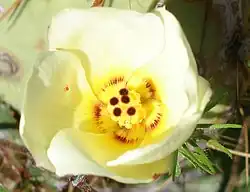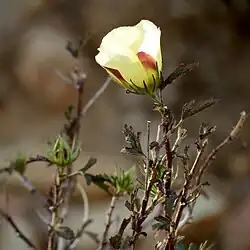Hibiscus coulteri
Hibiscus coulteri, is well-adapted to dry desert environments. It has hairy-like leaves that help conserve water, and its yellow flowers, which have reddish centers, bloom mainly after rain.[1] These species are very important when it comes to being pollinators during dry periods.[2] Although having a short life, Hibiscus coulteri is great for landscapes with dry areas because it can grow with very little water.[1]
| Hibiscus coulteri | |
|---|---|

| |
| Close-up of flower | |
.jpg)
| |
| Base becomes woody | |
| Scientific classification | |
| Kingdom: | Plantae |
| Clade: | Tracheophytes |
| Clade: | Angiosperms |
| Clade: | Eudicots |
| Clade: | Rosids |
| Order: | Malvales |
| Family: | Malvaceae |
| Genus: | Hibiscus |
| Species: | H. coulteri
|
| Binomial name | |
| Hibiscus coulteri | |
| Synonyms[3] | |
|
Hibiscus coulteri var. brevipedunculatus M.E.Jones | |
Hibiscus coulteri, the desert rosemallow, is a species of flowering plant in the family Malvaceae.[4] It is native to steep slopes and canyon walls in the eastern Sonoran Desert, and the Chihuahuan Desert of the southwestern US and northern Mexico.[3] A short-lived perennial shrub reaching 6 ft (1.8 m), it is recommended for xeriscaping.[4]
-
 Stems, leaves, and flower
Stems, leaves, and flower
References
- ^ a b "USDA Plants Database". plants.usda.gov. Retrieved 2024-10-23.
- ^ "Lady Bird Johnson Wildflower Center - The University of Texas at Austin". www.wildflower.org. Retrieved 2024-10-23.
- ^ a b "Hibiscus coulteri Harv. ex A.Gray". Plants of the World Online. Royal Botanic Gardens, Kew. Retrieved 5 March 2023.
- ^ a b "Hibiscus coulteri". Plant Database. Lady Bird Johnson Wildflower Center. 14 February 2023. Retrieved 5 March 2023.
... Desert Rose-mallow, Coulter Hibiscus